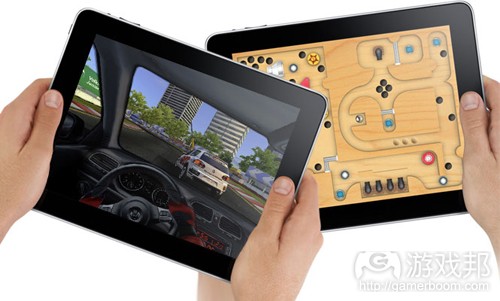Graeme Devine谈iPad游戏设计注意要点
作者:Ryan Geddes
游戏邦注:本文发稿于2011年3月2日,所涉时间、事件和数据均以此为准。
iPad开发群体都认为自己了解这个行业。一次性游戏销售量屡过百万,成为令人震惊的巨作,最终使得制作者脱离困境。在此风平浪静之际,正好可以好好反思在该行业能产生效果的做法。Graeme Devine为我们解决了这个问题。
Devine去年离开苹果iPhone游戏技术部门,回到家乡成为游戏开发者。在进入苹果之前,他曾在Ensemble Studios(游戏邦注:《光晕战争》、《帝国时代2》开发商)和id Software(游戏邦注:《雷神之锤3:竞技场》开发商)工作过,现在加入GRL Games制作iOS游戏。
在他的游戏开发生涯中,Devine掌握了某些如何制作出优秀游戏的技巧。他在2011年游戏开发者大会的小组讨论会上分享了某些相关内容。在题为“iPad Games: Touching the World on the Other Side of the Glass”的演讲中,Devine挑战某些为人普遍认可的iPad游戏设计论断。
iPad不是大型iPhone
苹果的这款平板电脑与手机在尺寸上有着显著差别。iPhone可以舒适地用单手握住,操作交给拇指或食指即可。但如果你花数分钟时间观察使用iPad的人,就会发现互动过程与手机大不相同。用户通常用一只手拿着设备,然后用另一只手来操作。这是种完全不同的体验。正是这种不同的体验引出Devine的下个观点。
不可将iPhone游戏直接移植到iPad
由于iPhone与iPad间存在差异,所以将以前者为平台设计的游戏直接移植到后者的想法并非明智之举。Devine告诉听众:“‘移植’是字典中最令人厌恶的词语。”App Store中失败的iPad游戏很多属于这个类别。
无需设置多余的虚拟操纵杆
我们都认同这个观点,但听到如此受人尊敬的开发者和我们有着类似的想法让人倍感欣慰。iPad的主要设计方向并非游戏设备,没有配套的按键、外部接口设备(游戏邦注:如鼠标或键盘)和操纵杆。那么,游戏开发者就无需硬生生地在iPad游戏中加入虚拟方向键和操纵杆。Devine说道:“当你在iPad游戏中设计双操纵杆时,是在向用户传达‘我的游戏用操纵杆玩起来感觉更好’这类信息。”我非常同意这种观点。
帧频影响游戏质量
通常,我们不觉得iPad需要令人眼花缭乱的快速帧频(游戏邦注:连续画面显示在屏幕上的频率)。但Devine辩称无论手指何时触摸屏幕,每款iPad游戏都需要将帧频稳定在60帧每秒,而不仅仅是射击游戏和竞速游戏。我们都曾有过类似的经历,iPad游戏跟不上点击或滑动的动作。即便是文字游戏或卡片游戏,低帧频也会使互动受到影响。Devine建议开发者确保iPad游戏在互动发生时稳定地将帧频保持在60帧每秒,空余时间再把帧频降下来,这样也可以减少耗电量。这种方法简单又实用。
为主界面按键添加存档功能
多数iPad用户希望他们在退出应用之时能够保存游戏进程。当然,大家寄希望让iOS系统自行实现这个目标,但是iPad游戏开发商对此也不容忽视。每款iPad游戏都应该在玩家按住主界面按键时自动保存游戏进程。当然,有些游戏会采用传统的多存档点系统。但Devine对开发商表示,如果可以尽量利用主界面按键。玩家在使用iPad时,希望能快速关闭和打开游戏。
让游戏成为用户与虚拟世界互动的窗口
其他游戏体验根本无法实现用户与游戏世界的亲密互动。对Devine来说,iPad游戏开发商的目标应该是帮助玩家接触整个虚拟世界。这听起来像是个很深奥的概念,但其实并不难。制作出相对自然的世界,引进屏幕接触作为互动方式。随后,驱除实现这种体验的障碍,直到玩家觉得他们真正身在你所制造的世界中。Devine表示《愤怒的小鸟》实现了上述概念。(本文为游戏邦/gamerboom.com编译,如需转载请联系:游戏邦)
Why So Many iPad Games Fail
Ryan Geddes
The world of iPad development is full of people who think they know what they’re doing. After all, one-off games frequently sell in the millions and become surprise hits, allowing their creators to finally move out of their mothers’ basements and buy shirts without hoods. But now that the dust has settled somewhat (ahead of yet more new construction), it’s a perfect time to get some perspective on what’s working and what’s not. Graeme Devine to the rescue.
Devine left Apple’s iPhone Game Technologies division last year to return to his roots as a game developer. And they’re deep roots. He worked at Ensemble Studios (Halo Wars, Age of Empires II) and id Software (Quake III Arena) before joining Apple, and now he’s making iOS games under the GRL Games moniker.
He’s learned a little something about how to make great games during his career, and he shared some of that knowledge during a panel at the 2011 Game Developers Conference in San Francisco this week. In a talk titled “iPad Games: Touching the World on the Other Side of the Glass”, Devine challenged some commonly held assumptions about designing games for Apple’s tablet.
The iPad is Not a Giant iPhone.
Despite what the haters say behind your back when you pull out your iPad at a coffee shop, Apple’s tablet is fundamentally different than its phone because of its dimensions. The iPhone was designed to fit comfortably in the palm of a single hand and operated with a thumb or forefinger (or nestled in two hands and tapped at by two opposing thumbs). Watch someone using an iPad for just a few minutes, and you’ll see that the interaction is completely different. Users typically support the device with one hand and interact with it using the other. It’s a completely different experience. Which leads directly into Devine’s next point….
iPhone-to-iPad Ports Are Evil.
Because the iPhone is not the iPad, the idea of taking a game designed for the former and bringing it over, whole hog, to the latter doesn’t make sense. “‘Port’ is the nastiest word in the dictionary,” Devine told the crowd. A quick scan of the App Store’s failed iPad games in that category supports his argument.
Virtual Joysticks Suck.
We all know it. But it’s comforting to hear a respected developer echo our thoughts. The iPad was not designed to be used primarily as a gaming device. It doesn’t have buttons, an external interface device (i.e. mouse or keyboard) or a joystick. So why are game makers shoehorning virtual directional pads and joysticks into their iPad titles? “When you put dual joysticks on an iPad game, what you’re saying to the user is, ‘my game is better with a joystick,’” Devine said. Couldn’t agree more.
Framerate Matters.
We don’t normally think of iPad games as screaming beasts with blazingly fast framerates (the frequencies at which consecutive images are displayed on a screen). But Devine argued that a steady 60 frames-per-second rate is essential for every iPad game, not just shooters and racers, whenever a finger is touching the screen. We’ve all experienced that moment of frustration when an iPad game can’t keep up with our taps or swipes. Even if it’s a word game or card game, a slow framerate kills the interaction. Devine’s advice to developers was to make sure iPad games hit a steady 60 frames-per-second when those interactions are happening and then ramp the rate down at other times, to save battery life. Simple and delicious.
The Home Button is the New Save Slot.
In most cases, iPad users expect their progress in a game to be retained when they navigate away from the application. Sure, the iOS is supposed to do that heavy lifting on its own, but iPad game developers depend on that at their peril. Every iPad game should save the player’s progress when the Home button is pressed. Sure, there are some games that will implement a classic system of multiple save slots (for multiple character playthroughs, etc.). But Devine told developers to stick to the Home button rule whenever possible. On the iPad, players need to shut games down and start them up quickly. Usually to hide a nerdy spellcasting minigame from a significant other by switching to the New York Times app.
It’s Not Just a Screen. It’s a Window.
No other game experience puts the user in such intimate contact with the world behind the screen. To Devine, the iPad game developer’s goal should be to help the gamer touch the world on the other side of the device’s display. It sounds high-concept, but it’s deceptively simple. Create a world that’s intuitive and invites touch interaction. Then strip away the things that get in the way until the player feels like he or she is actually manipulating the world you’ve created. Devine cited Angry Birds as a game that nailed this concept. (Source: IGN)








































 闽公网安备35020302001549号
闽公网安备35020302001549号